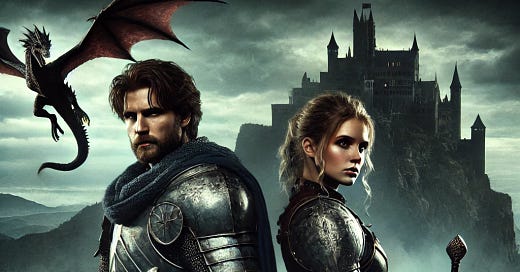Fantasy–Weapons and reality
It probably shocks no one that fantasy takes liberties with reality. And I want to reiterate that in no way am I saying that shouldn’t happen. But some misconceptions about medieval weapons have come about as a result, and I’d like to talk about them. Maybe so that they can be reworked in other ways, but more so that you readers of fantasy get some knowledge about these weapons you love.
These misconceptions are fairly minor, really, so let’s look at it all in good fun.
The Bow
The weapon of women. Whether it's Katniss Everdeen or Catti-Bri the bow is considered a nimble and fluid weapon, suited for the brisk speed and quick movements of a female character, and some male elves (hello Legolas). Perhaps it’s the bow’s finesse, or its grace, or any other aspect attributed to it, but lots of women use bows through the fantasy genre for fear that a woman using a sword and brawling with enemies twice again her size might break the verisimilitude.
And boy, is it a rough choice for anything nimble! True, the horseback archers of the Mongols and Turks were known for their swift strikes–but that was on horseback. The bow is a cumbersome, strength-reliant weapon. The force behind the bow, to have much effect on a lightly armored opponent, must have a 70–100-pound draw weight. You’d be better off putting a sword in the hand of your nimble female warrior–because the bow is slow and power dependent. Give the big beef cake the bow–it's more suited to Conan or Wulfgar.
The Long Sword
In opposition to the above, lots of characters wield the longsword and great sword as if they are weapons of pure brute force. Slamming into opponents with broad sweeping strikes that move slowly and carry great power. Whether it be Aragorn or Richard Cipher, these weapons seem more like Warhammers in their hands. They seem big, it’s true, with great swords getting up to six feet long at the extremes. But again, reality is quite the opposite.
Long swords were elegant and quick. They allow the user to pivot quickly and are weapons of extreme finesse. The rapier wasn’t the first sword where skill and speed mattered more than brute strength. A quick skilled sword master can negate the advantages of a larger opponent with more reach and strength than they possess. (Though reach and strength always matter, in a fight, they often matter less with a sword than other melee weapons.) We need to see more sword masters like Ciri, Arya, or Brienne of Tarth (though Ciri being able to teleport probably helps her too).
Is it really important?
I have to address this. “Is it important that these weapons be accurate in fiction,” and the answer is absolutely yes, it’s important: to nerds and no one else. So ultimately, no. It’s not important to get medieval weapons accurate while a dragon is attempting to snack on your upper torso.
But it’s sure fun to talk about!





Fun even for not-nerds!